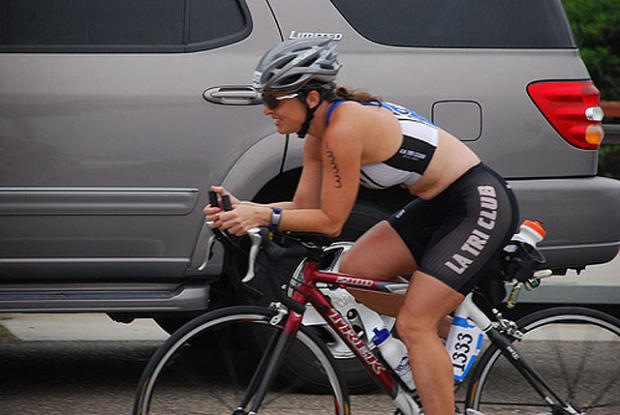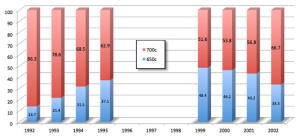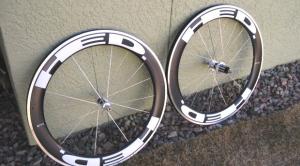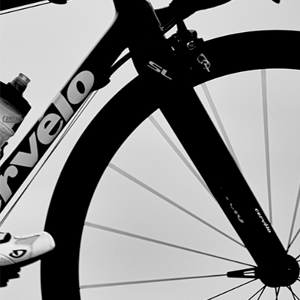[Publisher’s note: Gail wrote the following, her words, chronicling changes in her bike position from the very beginning until today, a 10-year journey from rank newbie to first road bike to 650c-wheel tri bike, her position morphing as her ardency and budget allowed.]
Brand new to triathlon, I bought a Trek WSD road bike from Helens Cycles in 2005 (replacing my Trek hybrid shown below, with grip shifters, which I rode wearing my old Reebok aerobic shoes). I didn’t really know how to ride my new Trek WSD and I had just discovered the L.A. Tri Club. I emailed its head coach Ian Murray and asked if he had time to teach me how not to fall off. “I'd love to help and I know a visit here would make a huge difference. Come for a fit and we'll do some basic instruction on clipping in and out, shifting, cadence, braking, etc.”

A few weeks later I won a set of aerobars at a raffle and as a triathlete-wannabe, I emailed Ian again to ask if I should put them on, put them in the closet for later, or give them away. His quick response: “I'm so glad you are happy with the bike and that you won those aero bars - awesome!! Let's do it this week. I think we should just add them to the bars.”

In 2007, after leg surgery and a lot of practice, I was happy 'til a tri-clubber shot this photo (above) of me at the Redondo Beach sprint tri.
I emailed the picture to Ian with a note saying only that I thought I looked too far back, and he replied with nothing more than, “See you Monday at 11.”

I left looking more like this above, which is a pic from the Santa Barbara Long Course Triathlon in 2008.
By the end of 2009, I decided it’s time for a tri bike. Ian did a pre-fit for me, taking measurements on his old Exit fit bike. I am just a bit over 5 feet tall, and we ultimately picked a bike based on Slowtwitch wisdom:

We ordered online and had it sent directly to Ian, and he built it up to my measurements and called me to come pick it up when he was done.
The pic below a month later at the Piru 20k TT.

Two-and-a-half years later, after a few more tweaks, here I was below at Ironman Canada in 2012:

Dan Empfield (Slowman) put out a call for “fit models” for a F.I.S.T. Tri Bike Fit Workshop in January, 2014, and I offered to provide a short-girl challenge for the advanced fit students. That clinic was led by Ian, Dan, and John Cobb.

Above is the position John put me in on the dynamic fit bike, with 155 crank length (as short as the adjustable cranks in the fit bike could go) and I couldn’t get as low in front as John wanted me to go (The fit bike maxed out).
Then the team told me to take a seat for a while as they swapped the stem to a shorter steeper angled one, cut off the barrel adjuster on the front brake to make it fit, raised the saddle, and set me up for 145 cranks.

And the outcome, back at the same spot on the Santa Barbara triathlon course, this time in 2015:

Below is what I look like now (February, 2017). I’d like my elbows a little closer together, I think, but the bike fit sure makes people talk! I ride lower than the passenger window on an SUV, and so I often take the lane so that I’m visible.
Could I have achieved this fit back in 2007? Maybe. I could have bought a tri bike back then, but I’m not sure I’d have easily found, for example, 145 cranks or the angled stem — and we didn’t have a lot of dynamic fit bikes back then. Pre-fits were rare; Pad X/Y wasn’t really part of the vocabulary. And, as a relative newbie, I doubt very much I’d have thought it was a good investment in a tri bike at all, and certainly not aftermarket parts like 145 cranks.

My takeaways:
• A great relationship with an outstanding fitter is worth way more than you pay for a single “bike fit.”
• Bike fit is part magic and part science.
• A “beginner” fit can (and should) be based on a combination of things, including flexibility, body weight, fitness, and maybe most important, budget for and availability of aftermarket parts.
• You can optimize fit even if you’re only five feet tall and MOP (and it helps to live near Xantusia, where F.I.S.T. Workshops take place).



